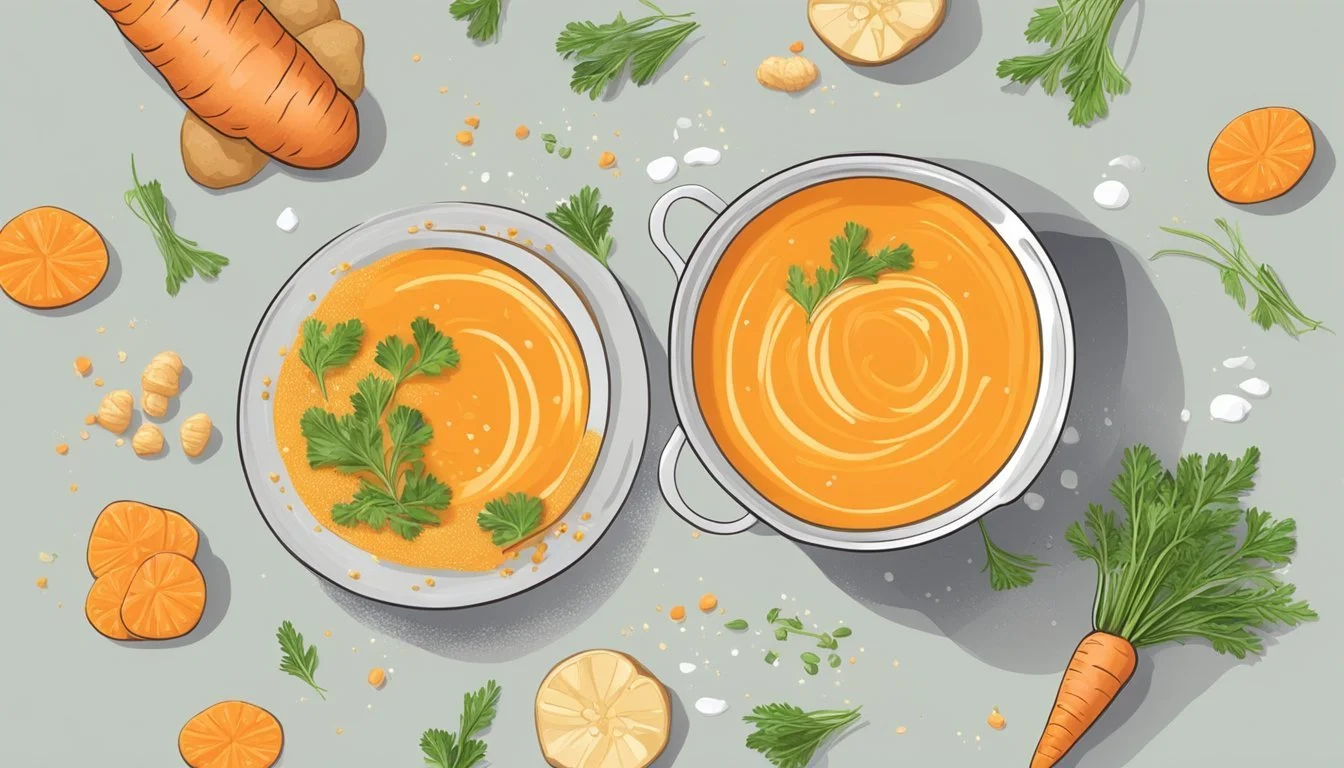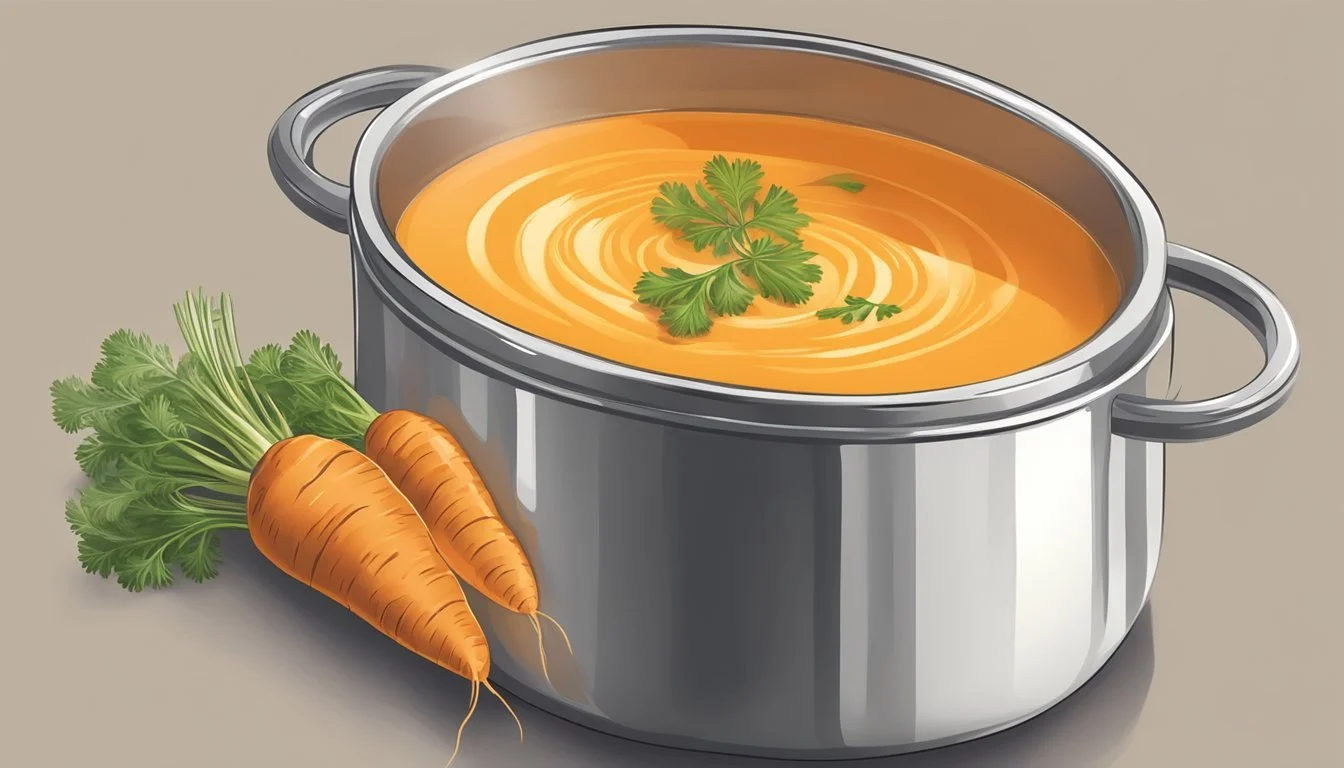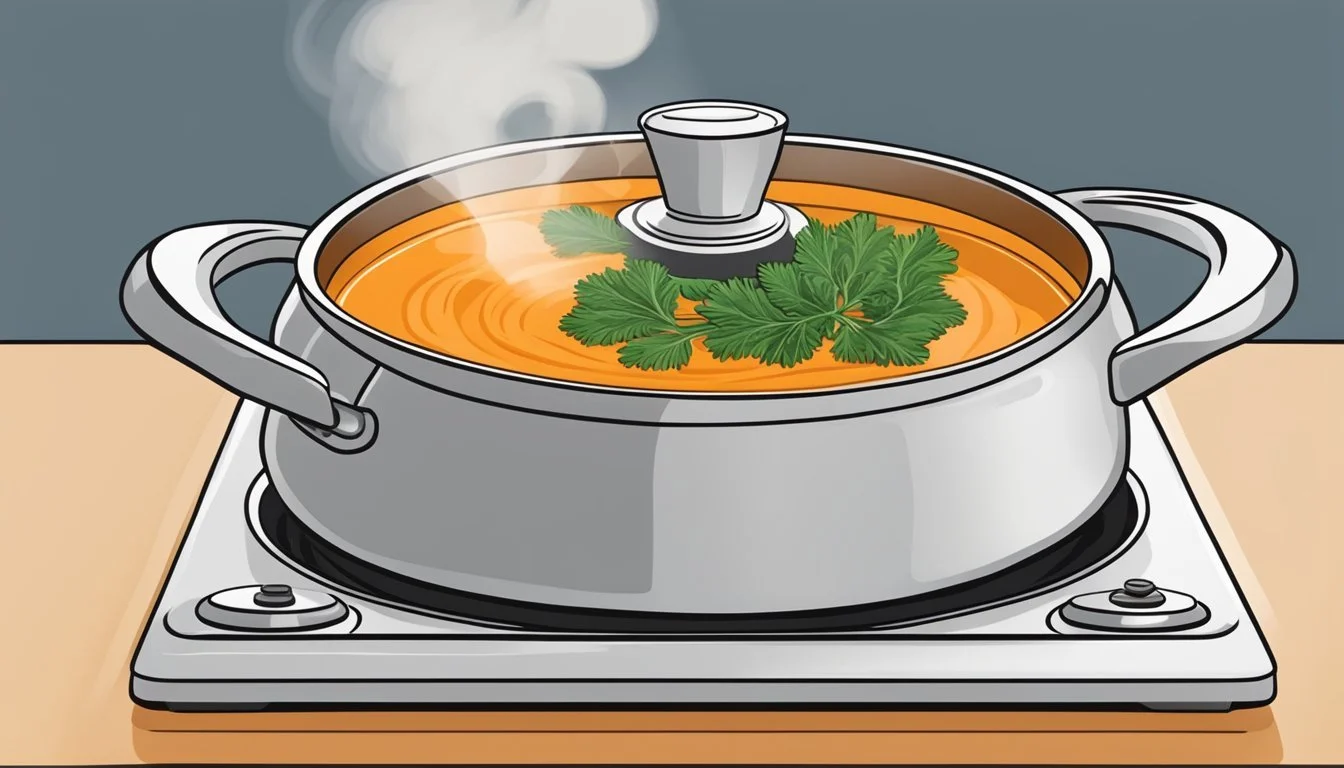Best Way to Reheat Carrot and Ginger Soup
Ensuring Consistent Texture and Flavor
Warming up a bowl of carrot and ginger soup can be more than just a way to satiate hunger; it’s also an act of preserving the nuanced flavors and creamy texture that make this dish comforting and satisfying. The vibrant orange hue of the soup, indicative of its nutritional value, is matched by the aromatic spice of ginger, which should be carefully maintained throughout the reheating process. Ensuring that these key elements remain intact allows for an enjoyable dining experience, as if the soup were freshly made.
The method one chooses for reheating this soup can significantly impact its taste and texture. The goal is to bring the soup to a pleasing temperature without compromising its silky smoothness or the integrity of its spices. It's important to avoid overheating, as this can dull the flavor of ginger and can lead to an undesirable change in texture. The techniques discussed utilize gentle heat to help preserve the essence of the soup.
Handling carrot and ginger soup with care during reheating will yield the best results. Using the right heat settings and reheating vessels can make the difference between a soup that’s just hot and one that seems to have freshly simmered on the stove. Whether it’s done on a stovetop or using other kitchen appliances, choosing the right approach will ensure the soup’s flavors are as vibrant as its color and as warming as its intention.
Understanding Carrot and Ginger Soup
Carrot and ginger soup is a blend of nutritiously dense vegetables and aromatic spices that create a harmonious, healthy, and often vegan dish. The primary ingredients, as the name suggests, include carrots and ginger, which are not only vibrant in color but also packed with vitamins and anti-inflammatory properties.
Carrots are the star vegetable in this soup and they provide a naturally sweet flavor along with beta-carotene, fiber, and antioxidants. Ginger, a versatile spice known for its zesty and warming taste, complements the sweetness of the carrots and adds depth to the soup's flavor profile. It also aids in digestion and boosts the immune system.
To prepare the soup, one typically begins by sautéing onions in olive oil until they are translucent. Freshly chopped carrots then join the pot, sweating out their flavors before ginger is added. For those seeking a dairy-free version, vegetable broth can be used as the liquid base, making the dish suitable for vegan diets. Alternatively, some recipes call for cream or coconut milk to add richness and a velvety texture without compromising on being dairy-free.
Lastly, a careful selection of spices — such as salt, pepper, and sometimes additional ingredients like garlic or onions — infuse the broth and contribute to a well-rounded taste. The spices must be perfectly balanced to maintain the soup's signature smoothness while accentuating its spicy ginger kick.
When prepared with care, carrot and ginger soup is not only appealing in taste but also in its health benefits, easily becoming a nutritious choice for any meal.
Optimal Storage Methods
Preserve the delightful essence of carrot and ginger soup by storing it correctly, allowing the retention of its smoothness and spicy flavor to extend over multiple servings.
Refrigerating Your Soup
When refrigerating carrot and ginger soup, it should be stored in an airtight container to maintain freshness. The refrigerator should be set at or below 40°F (4°C). Soup leftovers need to be cooled to room temperature within two hours before placing them in the refrigerator. They should be consumed within three to four days.
Storing Soup in the Freezer
Freezer storage is ideal for extending the shelf life of carrot and ginger soup. To freeze the soup, one should cool it to room temperature and then pour it into freezer-safe airtight containers or resealable freezer bags, leaving some space to account for expansion. The soup can be stored in the freezer for two to three months.
Important Freezing Tip: Label the container with the date to ensure the soup is used while at its best quality.
Container Choices for Storage
Choosing the right container is crucial for maintaining the quality of the soup:
Airtight containers made of glass or BPA-free plastic are preferred options for the refrigerator and freezer.
To prevent leaks in the freezer, one should opt for containers with tight-sealing lids.
If using resealable freezer bags, ensure all air is expelled before sealing and lay flat in the freezer for efficient use of space.
Note: When reheating, it’s recommended to transfer the frozen soup into the refrigerator to thaw overnight for best results.
Preparation Before Reheating
Proper preparation of carrot and ginger soup before reheating is essential to maintaining its smooth texture and vibrant spice profile. Attention to thawing and temperature adjustment will ensure safety and quality.
Thawing Frozen Soup
Freezing: If the soup is frozen, it should be transferred from the freezer to the refrigerator to thaw slowly. It typically takes 24 hours for soup to thaw safely in the refrigerator.
Safety: Avoid thawing soup at room temperature as it can lead to bacterial growth.
Bringing Refrigerated Soup to Room Temperature
Prep Time: Removing the soup from the refrigerator and letting it stand at room temperature for about 15 to 20 minutes before reheating can aid in more even warming.
Reheat: This small step in preparation helps minimize the temperature shock when reheating, preserving the soup’s consistency and flavors.
Reheating Techniques
Proper reheating preserves the creamy texture and the vibrant spices of carrot and ginger soup. Here's how to effectively revive the soup using three different heating methods.
Microwave Reheating Method
To reheat a creamy soup like carrot and ginger in a microwave, one should transfer the soup into a microwave-safe bowl. Ensure the bowl is covered with a microwave-safe lid or cover to prevent moisture loss. Steps for Microwave Reheating:
Heat on medium power for 2 minutes.
Stir to distribute heat evenly.
Heat in additional 30-second intervals if necessary, until the desired temperature is reached.
Stovetop Reheating Method
Reheating soup on the stove can help maintain its smooth consistency. A gentle and steady heat source prevents the soup from scorching or separating. Guidelines for Stovetop Reheating:
Pour the soup into a saucepan.
Heat slowly on a low-medium setting.
Stir frequently to avoid sticking and ensure even reheating.
Oven Reheating Approach
Although less common for soups (What wine goes well with soups?), one can opt for an oven reheating approach for a more gentle heating process, especially in larger quantities. Oven Reheating Instructions:
Preheat the oven to a moderate temperature, around 350°F (175°C).
Transfer the soup into an oven-safe dish.
Cover with foil and heat for about 20-30 minutes, stirring occasionally.
Maintaining Texture and Flavor
When reheating carrot and ginger soup, the smoothness and spice are paramount. To ensure the creamy texture remains intact, gentle reheating is essential. Start by transferring the soup to a saucepan and warming it over medium heat. Stirring occasionally prevents the bottom from scorching and promotes uniform heat distribution.
Incorporating a small amount of cream or fat can revive the richness of the soup. A dollop of butter or a swirl of olive oil introduced during reheating can enhance the flavor profile and add a silky finish, thus
Seasoning and Garnishing
In reheating carrot and ginger soup, attention to seasoning and garnishing is essential for restoring its vibrant taste and aroma. Proper seasoning can revitalize the flavors dulled by cooling and reheating.
Adjusting Salt and Pepper Levels
Before serving, taste the soup and adjust the levels of salt and pepper if necessary. A pinch of salt can bring back the soup's depth, while a twist of fresh ground pepper may enhance its warmth.
To Adjust Salt: Start with a small pinch, stir, taste, and repeat until the flavor is balanced.
To Adjust Pepper: Freshly ground black pepper is preferable for a punchier taste.
Herbs and Spices to Enhance Aroma
Reintroducing spices and herbs can amplify the soup's aroma and add complexity. A small amount of fresh ginger can revive the soup's signature zing, while garlic or onion sautéed in a pan for a minute can deepen the savory notes.
Fresh Herbs & Spices: Chopped chives or cilantro
Ground Spices: A pinch of cumin or coriander, to taste
Recommended Garnishes
A garnish not only adds visual appeal but also texture and flavor contrast. Sprinkle finely chopped herbs such as parsley or chives for freshness. To complement the soup's velvety consistency, serve with slices of crusty bread for dipping.
Herbs: Parsley, chives, or cilantro
Bread: Crusty baguette or whole-grain loaf
Dietary Considerations
When reheating carrot and ginger soup, one should consider dietary restrictions to ensure the meal remains suitable for various lifestyles and health requirements. Adjustments can be made for those following vegan, gluten-free, dairy-free, low-fat, or low-sodium diets without compromising the flavor and quality of the soup.
Making Soup Vegan-Friendly
To make carrot and ginger soup vegan-friendly, one must replace any animal-based ingredients with plant-based alternatives. For example:
Broth: Use vegetable broth instead of chicken or beef broth.
Cream: Substitute dairy cream with coconut milk or cashew cream to maintain creaminess.
This ensures the soup is free from animal products, suitable for vegans and vegetarians, and rich in plant-derived vitamins and fiber.
Gluten-Free and Dairy-Free Reheating
Individuals with gluten and dairy sensitivities require attentive ingredient substitutions. When reheating, consider:
Thickeners: Opt for gluten-free flour or pureed vegetables if the soup's consistency needs adjusting.
Dairy Products: Use dairy-free alternatives like almond or oat milk if the original recipe contains dairy.
These changes allow the soup to remain gluten-free and dairy-free, catering to those with allergies while providing essential nutrients like vitamin A and vitamin C.
Low-Fat and Low-Sodium Options
For a healthier version of carrot and ginger soup that is low in fat and sodium, one should:
Use low-sodium broth or simply water to reduce the overall sodium content.
Reduce or eliminate the use of oil when reheating to lower fat content.
These modifications are beneficial for those monitoring their fat and sodium intake while still wanting to enjoy a flavorful soup rich in protein and healthy nutrients.
Safety and Hygiene
When reheating carrot and ginger soup to maintain its smoothness and spice, one must be vigilant about safety and hygiene.
Refrigeration: Soup should be cooled to room temperature before being placed in the refrigerator. A safe and efficient method is using an ice bath; this involves placing the soup container in a larger container filled with ice water and stirring periodically.
Storage: Soup should be stored in airtight containers. For optimal safety, they should use shallow containers to facilitate quicker cooling, which inhibits bacterial growth.
Reheating: When reheating, they should bring the soup to a boil, regardless of the method used. This ensures that any potential bacteria are eliminated.
Containers and Utensils:
Containers: Utilize containers that are both clean and designed for food storage. Check for cracks or damages that can harbor bacteria.
Utensils: Before use, utensils must be thoroughly washed and sanitized to prevent the introduction of contaminants.
Personal Hygiene:
Individuals must wash their hands thoroughly with soap and water before handling food to minimize the risk of contamination.
Hair and clothing should be clean and, if necessary, covered to prevent any particles from falling into the soup.
Maintaining a clean workspace is crucial. Surfaces should be sanitized before and after preparing the soup to prevent the spread of bacteria. In following these guidelines, they can serve a safe and deliciously reheated carrot and ginger soup.
Serving and Pairing Suggestions
When reheating carrot and ginger soup, complementing it with the right side dishes and beverages can turn a simple meal into a gourmet experience. The goal is to enhance the smooth and spicy flavors of the soup without overpowering them.
Suitable Side Dishes
Breads:
Crusty Bread: A slice of warm, crusty bread adds a satisfying crunch and is ideal for soaking up the soup.
Grilled Cheese Sandwich: Works as a hearty accompaniment, with the melted cheese providing a creamy contrast.
Salads:
A light Spinach and Goat Cheese Salad offers a fresh and tangy side that pairs wonderfully with the warmth of the soup.
Wine and Beverage Pairings
Wine:
Riesling: A semi-sweet Riesling can complement the spicy and sweet notes of the carrot and ginger soup.
Chardonnay: For those preferring a dry option, an oaked Chardonnay can balance the soup's earthiness.
Other Beverages:
For a non-alcoholic option, a ginger tea can echo the flavors in the soup, intensifying its characteristic spice.
Conclusion
Reheating carrot and ginger soup while maintaining its appealing texture and distinctive flavor requires a gentle approach. It's essential to avoid high temperatures that can diminish the soup's smoothness and the vibrant spice of ginger. When using a microwave, one should heat the soup on medium power, stirring occasionally to ensure even heat distribution. Covering the soup during reheating is also advised to prevent splatter and retain moisture.
For those favoring traditional methods, a stovetop technique serves well. It is preferable to warm the soup on a medium-low setting, stirring frequently until it reaches the desired temperature. This method helps keep the soup's consistency fluid and the ginger's zing intact.
When storing, one must ensure that the carrot and ginger soup is cooled down to room temperature using a safe method, like an ice bath or natural cooling before refrigerating. Proper storage in an airtight container is crucial to preserve the soup's quality.
To summarize, the key steps to reheat carrot and ginger soup effectively include:
Use a microwave-safe bowl with a lid for microwave reheating
Employ medium power and stir the soup occasionally in the microwave
Reheat on the stovetop at medium-low heat with frequent stirring
Allow the soup to cool properly before storing to maintain freshness
Each reheating and cooling strategy helps maintain the soup's signature smoothness and spice, ensuring a delightful taste experience at every serving.






